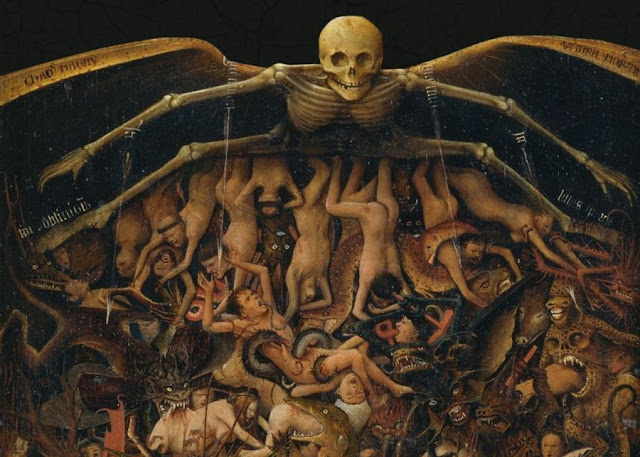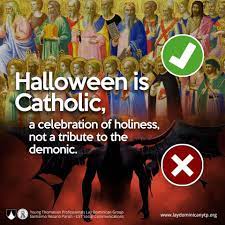From the Catholic Guy:
The days of the dead center around All Saints' Day (also known as All Hallows') on November 1, when we celebrate all the Saints in Heaven. On the day after All Hallows', called "All Souls' Day," we remember the saved souls who are in Purgatory, being cleansed of the temporal effects of their sins before they can enter Heaven. The day that comes before All Hallows', though, is one on which we unofficially remember the damned and the reality of Hell. The schema, then, for the Days of the Dead looks like this:
31 October:
Hallowe'en: unofficially, per folk custom, recalls the souls of the damned. Practices center around recognizing and remembering the reality of Hell and how to avoid it.
1 November:
All Saints': set aside to officially honor the Church Triumphant (the souls in Heaven). Practices center around recalling our great Saints, including those whose names are unknown to us and, so, are not canonized
2 November:
All Souls': set aside officially to pray for the Church Suffering (the souls in Purgatory). Practices center around praying for the souls in Purgatory, especially our loved ones
The earliest form of All Saints' (or "All Hallows'") was first celebrated in the 300s, but originally took place on 13 May, as it still does in some Eastern Churches. The Feast first commemorated only the martyrs, but came to include all of the Saints by 741. It was transferred to 1 November in 844 when Pope Gregory III consecrated a chapel in St. Peter's Basilica to All Saints (so much for the theory that the day was fixed on 1 November because Irish pagans had harvest festivals at that time).
All Souls' has its origins in A.D. 1048 when the Bishop of Cluny decreed that the Benedictines of Cluny pray for the souls in Purgatory on this day. The practice spread until Pope Sylvester II recommended it for the entire Latin Church.
The Vigil of -- i.e., the evening before -- All Hallows' ("Hallows' Eve," or "Hallowe'en") came, in Irish popular piety, to be a day of remembering the dead who are neither in Purgatory or Heaven, but are damned, and these customs spread to many parts of the world. Thus we have the popular focus of Hallowe'en as the reality of Hell, and hence its scary character and focus on evil and how to avoid it, the sad fate of unsaved souls, etc.
One hears too often from the secular world that "Hallowe'en is a pagan holiday" -- an impossibility because "Hallowe'en," as said, means "All Hallows' Evening" which is as Catholic as it gets. Some say that the holiday actually stems from Samhain, a pagan Celtic celebration, or is Satanic, but this isn't true, either, any more than Christmas "stems from" the Druids' Yule, though popular customs that predated the Church -- such as the use of holly to decorate -- may be involved in our celebrations (it is rather amusing that October 31 is also "Reformation Day" in Protestant circles -- the day to recall Luther's having nailed his 95 Theses to Wittenberg's cathedral door -- but Protestants who reject Hallowe'en because pagans do things on October 31 don't object to commemorating that event on this day).





16 comments:
I like your chasuble!
I've never heard that about remembering the damned on Oct 31st. I'm skeptical.
qwik - That idea is new to me also.
Such impoverished Catholic views of All Hallows' Eve:
Please view this website: https://www.occatholic.com/ghosts-ghouls-and-goblins-galore/
Money byte: “In contrast to popular culture’s observance of Halloween, even the customary appeal to the ‘frightful’ has a devotional meaning in the Catholic tradition,” Bishop Konderla notes. “Props such as skulls and scythes have historically recalled our mortality, reminding us to be holy because we are destined for judgment.” He cites Hebrews 9:27 and Revelation 14:15: “Visible symbols of death represent a reminder of the last things — death, judgment, heaven and hell.”
Money byte, me.
Recalling our mortality is not a practice that, "...recalls the souls of the damned." with "Practices center around recognizing and remembering the reality of Hell and how to avoid it."
Skulls and scythes are symbols of death, not damnation.
Says the guy who votes for the Party of Abortion is "healthcare."
Skull and crossbones typically symbolize Adam's fall and mortality, which Jesus healed by his passion, death, decent into Hades and resurrection.
*At least as it pertains to Eastern portrayals of the Crucifixion.
O my, the four Last things, death, judgment, heave or hell. Demons and monstrous humans damned for eternity. Costumes All Hallows Eve symbolize the 4th Last Things. Do you just preach on three of the four??? O my!
Father McDonald,
Your cross to bare arrives here frequently. He needs help
Tempus fugit. Memento mori. I think there has been a Protestant-izing of our traditions with excess avoidance of ghoulish images lest they tempt us to Satan. Not a bad idea in itself, except that, as FrMJK points out these are symbols of death and we can see the fate of those who despair of the Resurrection and can use the images to remind us of the worst alternative.
"Some say that the holiday actually stems from Samhain, a pagan Celtic celebration, or is Satanic, but this isn't true,..."
Yeah, it is true.
"Halloween began as the Celtic festival of Samhain, the Lord of the dead in Celtic mythology. It was believed that on the night before the feast, the gates of the underworld were opened and that ghosts, demons, and witches were allowed to roam freely. In response to this otherworldly menace, the Celts followed the principle “if you can’t beat ’em, join ’em” and disguised themselves as various kinds of ghouls to escape harm. (From this practice comes our custom of Halloween masquerading). And in addition to blending in with the infernal, the Celts also tried to appease evil spirits by offering them food and wine. After the Catholic faith came to Celtic lands, the old Druidic festival was associated with the night before All Saints’ Day and was thus called All Hallows’ Eve (a name that gives us the modern appellation of Halloween), even though the institution of All Saints’ Day on November 1 was a complete coincidence."
- Michael Foley, Tuesday, October 31, 2023 All Hallows’ Eve "New Liturgical movement"
TJM,
Which one?
Nick
Nick,
Good point. I was referring to the condescending clerical one.
Proceed to the 1:47 mark to view a funny (I hope that you'll agree) Halloween-related blast from the past.
https://www.youtube.com/watch?v=GYn8h-VWslg
Pax.
Mark Thomas
Post a Comment